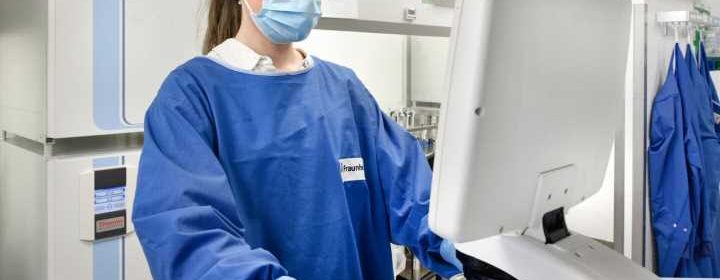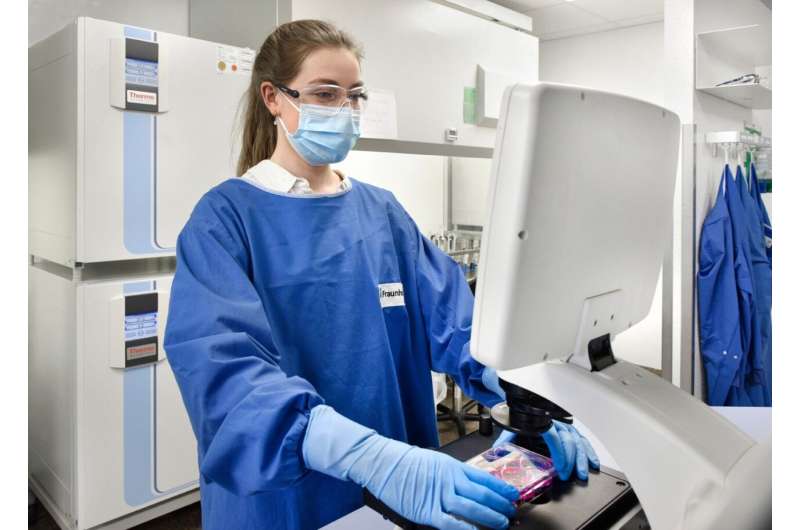Proxidrugs in the fight against pathogenic proteins

Cells have an efficient waste disposal system. Proxidrugs utilize this system as part of new treatments for cancer, infections and Alzheimer’s disease. Scientists at the Fraunhofer Institute for Translational Medicine and Pharmacology ITMP are working with partners to develop this new drug class.
Dr. Aimo Kannt, head of drug discovery and preclinical research at Fraunhofer ITMP in Frankfurt, is currently researching a new class of drugs with sustained efficacy. “Traditional drugs work by binding to pathogenic proteins and blocking or inhibiting their function. Proxidrugs, however, destroy the pathogenic protein and therefore have a longer-lasting effect,” explains the scientist.
He is convinced that this new drug class, known as “proxidrugs” (short for proximity-inducing drugs), will open up exciting new possibilities. “Eighty percent of all possible protein target structures are inaccessible to current active pharmaceutical ingredients. We could reach many of these using proxidrugs and develop treatments for currently incurable diseases.”
Intensive research in this field is being carried out around the world. The first clinical trials are already underway. However, there is still a long way to go before the new active substances are available to patients as a standard of care. Aimo Kannt, together with a consortium of universities and industry players, is paving part of this way within the framework of the “PROXIDRUGS” project.
Proxidrugs eliminate the cause of the disease
The inhibitory effect of traditional drugs immediately starts to wear off when the drug is metabolized in the body. Drugs such as antihypertensives must therefore be taken frequently and on a regular basis. Proxidrugs, in the contrary, cause degradation of the pathogenic protein and thus eliminate the cause of the disease. To trigger degradation, they utilize proteasomes, the cell’s own protein “shredders.” These are part of an efficient cellular recycling strategy: A biological monitoring system continuously searches for defective proteins. If such a protein is detected, it is marked with a “flag,” a molecule called ubiquitin. This ubiquitin marker acts as a recognition signal for the proteasome—a barrel-shaped protein complex—which then captures the ubiquitinated protein. Once captured, the unwanted protein is unfolded and broken down into smaller components.
Harnessing the cell’s own waste removal system
Proxidrugs cause the disease-related proteins to be marked with an ubiquitin flag. They are thus recognized as waste by the cell’s own waste removal system and degraded by the proteasome. The technical implementation is difficult. The ubiquitin flag is attached to the protein by means of a special enzyme, the E3 ligase. Proxidrugs are designed so that they can bind to the target protein on the one side and to the E3 ligase on the other. The proximity induced between the target protein and the E3 ligase is what is naming this entire substance class.
“With the PROXIDRUGS project, we are addressing all aspects associated with these types of compounds,” says Aimo Kannt. The consortium consists of 10 partners, including the Goethe University Frankfurt (coordinating institution), the Technical University of Darmstadt, the Max Planck Institute of Biophysics and the pharmaceutical companies Merck and Abbvie.
Targeting cancer, neurodegenerative diseases and infectious diseases
The project is focusing on three indications: cancer, neurodegenerative diseases and infectious diseases. In all three fields, the aim is to eliminate the proteins that promote disease progression. In the case of cancer, for example, these are messenger substances that cause tumor cells to grow. In the field of neurodegenerative diseases, such as Alzheimer’s disease, the goal is to target proteins that are involved in the formation of deposits in the central nervous system. Fraunhofer ITMP is taking the lead for this subproject.
New strategy to fight multidrug-resistant germs
Proxidrugs offer a completely new approach to fight infectious diseases and to find effective new drugs to tackle multidrug-resistant bacteria. Among others, the project is focusing on Acinetobacter baumannii, a dangerous hospital pathogen that causes, for example, pneumonia and wound infections.
Source: Read Full Article
